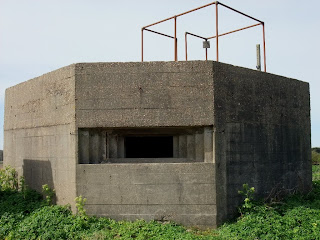Following on from a recent comment on the blog, I thought I'd post the photos of the twin Vickers Machine gun pillbox, Benacre - visited in April but just never got round to posting. I think the pillbox was also used as an Observer Corps post after the war; safety rails for the observation post still visible although the underground post has been infilled. Several Suffolk Square Pillboxes can also be seen in the area (think I have already posted on these, but lose track these days) as well as some remains of concrete tank blocks on the track which exits the beach.
Coastal erosion continues to reveal the drainage system of military camps in the area, no doubt something new revealed (as well as lost) every year.
Kessingland Coastal Battery now on website. Next post shortly on RAF Station 373.
Kessingland Coastal Battery now on website. Next post shortly on RAF Station 373.
Image 1 & 2: Twin Vickers machine gun pillbox. Other surviving examples can be seen at Blythburgh and Dunwich. Note rails of ROC post on top.
Image 3: Telephone mast(?), ROC post
Image 4 -7: Showing the two gun positions separated by a anti-ricochet wall, the tables on which the Vickers mg would have sat on and the fields of fire from the embrasures.
Image 8: Remains of tank traps on the track leading off the beach.
Image 9: Section of 4" glazed stoneware drain pipe
Image 10: Remains of drain manhole
Image 3: Telephone mast(?), ROC post
Image 4 -7: Showing the two gun positions separated by a anti-ricochet wall, the tables on which the Vickers mg would have sat on and the fields of fire from the embrasures.
Image 8: Remains of tank traps on the track leading off the beach.
Image 9: Section of 4" glazed stoneware drain pipe
Image 10: Remains of drain manhole










Comments
Post a Comment